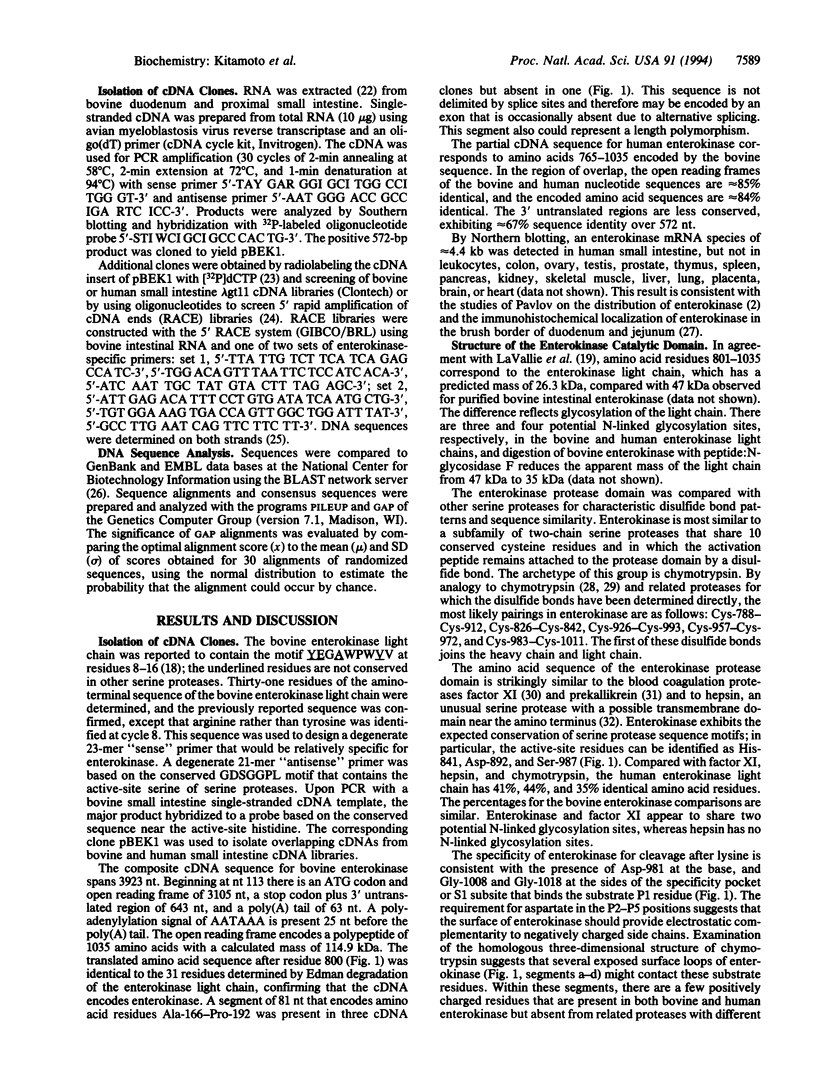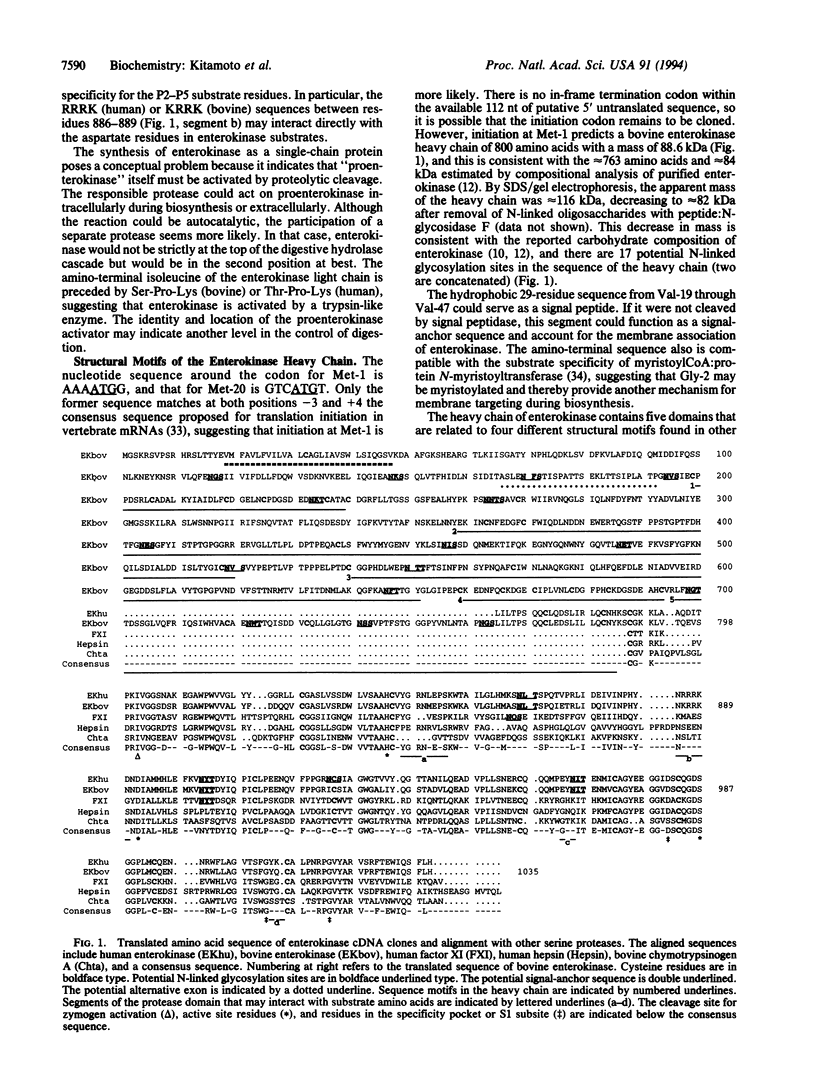Abstract
Enterokinase is a protease of the intestinal brush border that specifically cleaves the acidic propeptide from trypsinogen to yield active trypsin. This cleavage initiates a cascade of proteolytic reactions leading to the activation of many pancreatic zymogens. The full-length cDNA sequence for bovine enterokinase and partial cDNA sequence for human enterokinase were determined. The deduced amino acid sequences indicate that active two-chain enterokinase is derived from a single-chain precursor. Membrane association may be mediated by a potential signal-anchor sequence near the amino terminus. The amino terminus of bovine enterokinase also meets the known sequence requirements for protein N-myristoylation. The amino-terminal heavy chain contains domains that are homologous to segments of the low density lipoprotein receptor, complement components C1r and C1s, the macrophage scavenger receptor, and a recently described motif shared by the metalloprotease meprin and the Xenopus A5 neuronal recognition protein. The carboxyl-terminal light chain is homologous to the trypsin-like serine proteases. Thus, enterokinase is a mosaic protein with a complex evolutionary history. The amino acid sequence surrounding the amino terminus of the enterokinase light chain is ITPK-IVGG (human) or VSPK-IVGG (bovine), suggesting that single-chain enterokinase is activated by an unidentified trypsin-like protease that cleaves the indicated Lys-Ile bond. Therefore, enterokinase may not be the "first" enzyme of the intestinal digestive hydrolase cascade. The specificity of enterokinase for the DDDDK-I sequence of trypsinogen may be explained by complementary basic-amino acid residues clustered in potential S2-S5 subsites.
Full text
PDF




Images in this article
Selected References
These references are in PubMed. This may not be the complete list of references from this article.
- Abita J. P., Delaage M., Lazdunski M. The mechanism of activation of trypsinogen. The role of the four N-terminal aspartyl residues. Eur J Biochem. 1969 Apr;8(3):314–324. doi: 10.1111/j.1432-1033.1969.tb00530.x. [DOI] [PubMed] [Google Scholar]
- Anderson L. E., Walsh K. A., Neurath H. Bovine enterokinase. Purification, specificity, and some molecular properties. Biochemistry. 1977 Jul 26;16(15):3354–3360. doi: 10.1021/bi00634a011. [DOI] [PubMed] [Google Scholar]
- Baratti J., Maroux S., Louvard D., Desnuelle P. On porcine enterokinase. Further purification and some molecular properties. Biochim Biophys Acta. 1973 Jul 5;315(1):147–161. doi: 10.1016/0005-2744(73)90138-1. [DOI] [PubMed] [Google Scholar]
- Baratti J., Maroux S. On the catalytic and binding sites of porcine enteropeptidase. Biochim Biophys Acta. 1976 Dec 8;452(2):488–496. doi: 10.1016/0005-2744(76)90199-6. [DOI] [PubMed] [Google Scholar]
- Bricteux-Grégoire S., Schyns R., Florkin M. Phylogeny of trypsinogen activation peptides. Comp Biochem Physiol B. 1972 May 15;42(1):23–39. doi: 10.1016/0305-0491(72)90055-7. [DOI] [PubMed] [Google Scholar]
- Brown J. R., Hartley B. S. Location of disulphide bridges by diagonal paper electrophoresis. The disulphide bridges of bovine chymotrypsinogen A. Biochem J. 1966 Oct;101(1):214–228. doi: 10.1042/bj1010214. [DOI] [PMC free article] [PubMed] [Google Scholar]
- Chomczynski P., Sacchi N. Single-step method of RNA isolation by acid guanidinium thiocyanate-phenol-chloroform extraction. Anal Biochem. 1987 Apr;162(1):156–159. doi: 10.1006/abio.1987.9999. [DOI] [PubMed] [Google Scholar]
- Chung D. W., Fujikawa K., McMullen B. A., Davie E. W. Human plasma prekallikrein, a zymogen to a serine protease that contains four tandem repeats. Biochemistry. 1986 May 6;25(9):2410–2417. doi: 10.1021/bi00357a017. [DOI] [PubMed] [Google Scholar]
- DAVIE E. W., NEURATH H. Identification of a peptide released during autocatalytic activation of trypsinogen. J Biol Chem. 1955 Feb;212(2):515–529. [PubMed] [Google Scholar]
- Dangott L. J., Jordan J. E., Bellet R. A., Garbers D. L. Cloning of the mRNA for the protein that crosslinks to the egg peptide speract. Proc Natl Acad Sci U S A. 1989 Apr;86(7):2128–2132. doi: 10.1073/pnas.86.7.2128. [DOI] [PMC free article] [PubMed] [Google Scholar]
- Feinberg A. P., Vogelstein B. A technique for radiolabeling DNA restriction endonuclease fragments to high specific activity. Anal Biochem. 1983 Jul 1;132(1):6–13. doi: 10.1016/0003-2697(83)90418-9. [DOI] [PubMed] [Google Scholar]
- Fonseca P., Light A. Incorporation of bovine enterokinase in reconstituted soybean phospholipid vesicles. J Biol Chem. 1983 Mar 10;258(5):3069–3074. [PubMed] [Google Scholar]
- Fonseca P., Light A. The purification and characterization of bovine enterokinase from membrane fragments in the duodenal mucosal fluid. J Biol Chem. 1983 Dec 10;258(23):14516–14520. [PubMed] [Google Scholar]
- Freeman M., Ashkenas J., Rees D. J., Kingsley D. M., Copeland N. G., Jenkins N. A., Krieger M. An ancient, highly conserved family of cysteine-rich protein domains revealed by cloning type I and type II murine macrophage scavenger receptors. Proc Natl Acad Sci U S A. 1990 Nov;87(22):8810–8814. doi: 10.1073/pnas.87.22.8810. [DOI] [PMC free article] [PubMed] [Google Scholar]
- Frohman M. A., Dush M. K., Martin G. R. Rapid production of full-length cDNAs from rare transcripts: amplification using a single gene-specific oligonucleotide primer. Proc Natl Acad Sci U S A. 1988 Dec;85(23):8998–9002. doi: 10.1073/pnas.85.23.8998. [DOI] [PMC free article] [PubMed] [Google Scholar]
- Fujikawa K., Chung D. W., Hendrickson L. E., Davie E. W. Amino acid sequence of human factor XI, a blood coagulation factor with four tandem repeats that are highly homologous with plasma prekallikrein. Biochemistry. 1986 May 6;25(9):2417–2424. doi: 10.1021/bi00357a018. [DOI] [PubMed] [Google Scholar]
- Gish W., States D. J. Identification of protein coding regions by database similarity search. Nat Genet. 1993 Mar;3(3):266–272. doi: 10.1038/ng0393-266. [DOI] [PubMed] [Google Scholar]
- Hadorn B., Tarlow M. J., Lloyd J. K., Wolff O. H. Intestinal enterokinase deficiency. Lancet. 1969 Apr 19;1(7599):812–813. doi: 10.1016/s0140-6736(69)92071-6. [DOI] [PubMed] [Google Scholar]
- Hartley B. S., Kauffman D. L. Corrections to the amino acid sequence of bovine chymotrypsinogen A. Biochem J. 1966 Oct;101(1):229–231. doi: 10.1042/bj1010229. [DOI] [PMC free article] [PubMed] [Google Scholar]
- Haworth J. C., Gourley B., Hadorn B., Sumida C. Malabsorption and growth failure due to intestinal enterokinase deficiency. J Pediatr. 1971 Mar;78(3):481–490. doi: 10.1016/s0022-3476(71)80231-7. [DOI] [PubMed] [Google Scholar]
- Hermon-Taylor J., Perrin J., Grant D. A., Appleyard A., Bubel M., Magee A. I. Immunofluorescent localisation of enterokinase in human small intestine. Gut. 1977 Apr;18(4):259–265. doi: 10.1136/gut.18.4.259. [DOI] [PMC free article] [PubMed] [Google Scholar]
- Hewick R. M., Hunkapiller M. W., Hood L. E., Dreyer W. J. A gas-liquid solid phase peptide and protein sequenator. J Biol Chem. 1981 Aug 10;256(15):7990–7997. [PubMed] [Google Scholar]
- Jiang W., Gorbea C. M., Flannery A. V., Beynon R. J., Grant G. A., Bond J. S. The alpha subunit of meprin A. Molecular cloning and sequencing, differential expression in inbred mouse strains, and evidence for divergent evolution of the alpha and beta subunits. J Biol Chem. 1992 May 5;267(13):9185–9193. [PubMed] [Google Scholar]
- Johnson G. D., Hersh L. B. Cloning a rat meprin cDNA reveals the enzyme is a heterodimer. J Biol Chem. 1992 Jul 5;267(19):13505–13512. [PubMed] [Google Scholar]
- Kozak M. An analysis of vertebrate mRNA sequences: intimations of translational control. J Cell Biol. 1991 Nov;115(4):887–903. doi: 10.1083/jcb.115.4.887. [DOI] [PMC free article] [PubMed] [Google Scholar]
- LaVallie E. R., Rehemtulla A., Racie L. A., DiBlasio E. A., Ferenz C., Grant K. L., Light A., McCoy J. M. Cloning and functional expression of a cDNA encoding the catalytic subunit of bovine enterokinase. J Biol Chem. 1993 Nov 5;268(31):23311–23317. [PubMed] [Google Scholar]
- Laemmli U. K. Cleavage of structural proteins during the assembly of the head of bacteriophage T4. Nature. 1970 Aug 15;227(5259):680–685. doi: 10.1038/227680a0. [DOI] [PubMed] [Google Scholar]
- Leytus S. P., Kurachi K., Sakariassen K. S., Davie E. W. Nucleotide sequence of the cDNA coding for human complement C1r. Biochemistry. 1986 Aug 26;25(17):4855–4863. doi: 10.1021/bi00365a020. [DOI] [PubMed] [Google Scholar]
- Leytus S. P., Loeb K. R., Hagen F. S., Kurachi K., Davie E. W. A novel trypsin-like serine protease (hepsin) with a putative transmembrane domain expressed by human liver and hepatoma cells. Biochemistry. 1988 Feb 9;27(3):1067–1074. doi: 10.1021/bi00403a032. [DOI] [PubMed] [Google Scholar]
- Liepnieks J. J., Light A. The preparation and properties of bovine enterokinase. J Biol Chem. 1979 Mar 10;254(5):1677–1683. [PubMed] [Google Scholar]
- Light A., Janska H. The amino-terminal sequence of the catalytic subunit of bovine enterokinase. J Protein Chem. 1991 Oct;10(5):475–480. doi: 10.1007/BF01025475. [DOI] [PubMed] [Google Scholar]
- Magee A. I., Grant D. A., Taylor J. H. Further studies on the subunit structure and oligosaccharide moiety of human enterokinase. Clin Chim Acta. 1981 Sep;115(3):241–254. doi: 10.1016/0009-8981(81)90238-2. [DOI] [PubMed] [Google Scholar]
- Maroux S., Baratti J., Desnuelle P. Purification and specificity of porcine enterokinase. J Biol Chem. 1971 Aug 25;246(16):5031–5039. [PubMed] [Google Scholar]
- Neurath H. Evolution of proteolytic enzymes. Science. 1984 Apr 27;224(4647):350–357. doi: 10.1126/science.6369538. [DOI] [PubMed] [Google Scholar]
- Rudnick D. A., McWherter C. A., Gokel G. W., Gordon J. I. MyristoylCoA:protein N-myristoyltransferase. Adv Enzymol Relat Areas Mol Biol. 1993;67:375–430. doi: 10.1002/9780470123133.ch5. [DOI] [PubMed] [Google Scholar]
- Sanger F., Nicklen S., Coulson A. R. DNA sequencing with chain-terminating inhibitors. Proc Natl Acad Sci U S A. 1977 Dec;74(12):5463–5467. doi: 10.1073/pnas.74.12.5463. [DOI] [PMC free article] [PubMed] [Google Scholar]
- Shimell M. J., Ferguson E. L., Childs S. R., O'Connor M. B. The Drosophila dorsal-ventral patterning gene tolloid is related to human bone morphogenetic protein 1. Cell. 1991 Nov 1;67(3):469–481. doi: 10.1016/0092-8674(91)90522-z. [DOI] [PubMed] [Google Scholar]
- Südhof T. C., Goldstein J. L., Brown M. S., Russell D. W. The LDL receptor gene: a mosaic of exons shared with different proteins. Science. 1985 May 17;228(4701):815–822. doi: 10.1126/science.2988123. [DOI] [PMC free article] [PubMed] [Google Scholar]
- Takagi S., Hirata T., Agata K., Mochii M., Eguchi G., Fujisawa H. The A5 antigen, a candidate for the neuronal recognition molecule, has homologies to complement components and coagulation factors. Neuron. 1991 Aug;7(2):295–307. doi: 10.1016/0896-6273(91)90268-5. [DOI] [PubMed] [Google Scholar]



